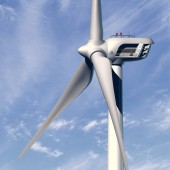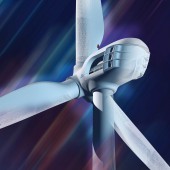Britannia 10MW Offshore Wind Turbine by Créa Inc Design |
Home > Winners > #70235 |
 |
|
||||
| DESIGN DETAILS | |||||
| DESIGN NAME: Britannia PRIMARY FUNCTION: 10MW Offshore Wind Turbine INSPIRATION: Brittania has stylistic inspiration from the nautical heritage of Clipper, the Clipper ship itself, and is expressed in the galley like rear end forms as well as the streamlined shape. CEO/Founder Jim Dehlson, “the father of modern Windpower,” expressed his aspiration for Britannia was the sculpture of “Winged Victory of Samothrace.” The exterior was designed to embody elements such as the arched wings, to create a mega sized inspirational sculpture. Function is integrated throughout the form, including the placement of Radiators to create the galley form and walkway under the Wing forms. UNIQUE PROPERTIES / PROJECT DESCRIPTION: The Britannia is mega-scale wind turbine proposed for offshore wind farms in the United Kingdom, the largest in the world and first to produce 10Mw of power. The exterior styling differentiates Clipper turbines and is designed to evoke company heritage and inspiration. Placement of the radiators to cooling the large generators, allowed the use of air scoops as stylistic elements. The interior architecture is optimized for people to work and sleep inside the large space to service the generators. OPERATION / FLOW / INTERACTION: Britannia is built in modular pieces & transported via highways/ ships to assembly site – each w/ challenges because of scale. On site, the tower would be built then modular parts are hoisted into place. 1st internal frame, then exterior pieces. Internal cranes lift generators & radiators into place. The cone would be added, then blades installed. During use, generators could be dismantled internally or replaced with bomb-bay doors. Technicians could arrive via helipad or lifted from ships. PROJECT DURATION AND LOCATION: The project started in December 2008, in Santa Barbara California (USA), San Francisco (USA), and Bristol (UK). The industrial design phase of the project was completed in March 2010. |
PRODUCTION / REALIZATION TECHNOLOGY: Engineering teams developed generators, gearing, blades, & steel structure. It was starting point for exterior design & interior crew architecture. Turbine generator cooling is important (many catch fire) and placement of radiators was carefully considered for impact. Crew required internal space for removing, servicing, & replacing large generators. Windows, walkways, and sleep areas were positioned for crew comfort. Bomb-bay doors located for ship access. Helipad access on roof was planned. SPECIFICATIONS / TECHNICAL PROPERTIES: It generates 10Mw of energy, electricity for instantaneous demand of 7,500 homes at once. Height 180m Bladespan145m Generators replaced by lower/raising from ships with built in crane & moved internally to position. Crew delivered to roof helipad & can sleep onboard. Doors/windows added for comfort. External panels made from fibreglass composite mounted to internal i-beam structure. Blades made from single composite molding. Fabricated in road transportable modules because of large size. TAGS: Wind Turbine, Energy, Generator, Brittannia, Clipper Windpower, Offshore, Green Power, Renewable Energy RESEARCH ABSTRACT: Some people dislike look & noise of wind turbines, while suppliers want more efficiency/turbine. We solve these problems w/ mega-scale & design. Mega turbines produce more power, reducing number. Big size increases friction & heat, so radiators are essential. Scale allows internal cranes, bomb-bay doors, & habitability. Modular construction facilitates assembly. ID aim was to increase beauty w/ efficient engineering solutions – to create an iconic shape in sky, representing Clipper & renewable power. CHALLENGE: The hardest part of the engineering challenge was working with such a large scale product - engineering requirements were extreme including fabrication, assembly, mechanics, etc... all affecting the industrial design options. ADDED DATE: 2018-08-10 07:51:45 TEAM MEMBERS (5) : Project Lead: Jim Dehlson, Program Manager: Anthony Chobot, Engineering Lead: Erik Smith, Brand Manager: Steven Fischer and Industrial Design: Travis Baldwin IMAGE CREDITS: Industrial Designer Travis Baldwin, Britannia Visuals, 2010. Illustration Clipper Windpower, Product Paintings, 2010-2011. |
||||
| Visit the following page to learn more: http://www.argoresources.com/images/wpe_ |
|||||
| AWARD DETAILS | |
 |
Britannia 10mw Offshore Wind Turbine by Créa Inc Design is Winner in Energy Products, Projects and Devices Design Category, 2018 - 2019.· Read the interview with designer Créa Inc Design for design Britannia here.· Press Members: Login or Register to request an exclusive interview with Créa Inc Design. · Click here to register inorder to view the profile and other works by Créa Inc Design. |
| SOCIAL |
| + Add to Likes / Favorites | Send to My Email | Comment | Testimonials | View Press-Release | Press Kit |
Did you like Créa Inc Design's Energy Design?
You will most likely enjoy other award winning energy design as well.
Click here to view more Award Winning Energy Design.








